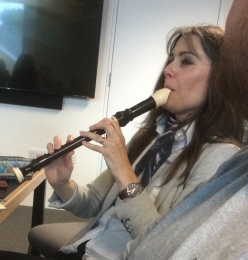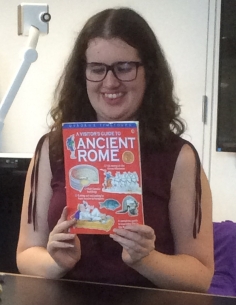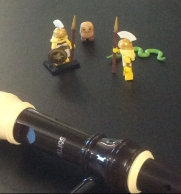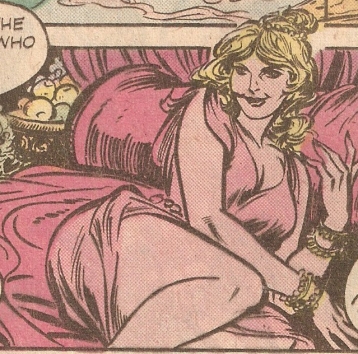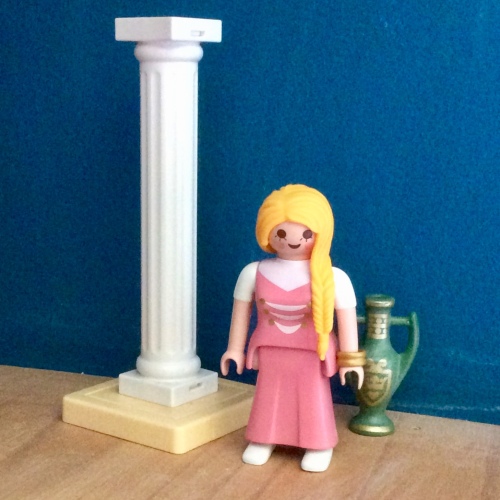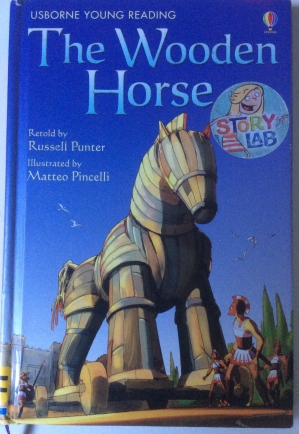 My previous blog posts have shared the experience of attending the Our Mythical Childhood show and tell at the University of Roehampton, but whilst I talked about other people’s contributions I didn’t discuss mine. The book I chose to share with everyone was The Wooden Horse retold by Russell Punter, and illustrated by Matteo Pincelli. It is an Usborne Young Reading (series 1) book, and was first published in 2011. Unlike some of the contributors to the event, this book was not one from my childhood, I had only come across it about about a year ago when I had started looking at Helen of Troy in comics, graphic novels, and children’s illustrated/picture books.
My previous blog posts have shared the experience of attending the Our Mythical Childhood show and tell at the University of Roehampton, but whilst I talked about other people’s contributions I didn’t discuss mine. The book I chose to share with everyone was The Wooden Horse retold by Russell Punter, and illustrated by Matteo Pincelli. It is an Usborne Young Reading (series 1) book, and was first published in 2011. Unlike some of the contributors to the event, this book was not one from my childhood, I had only come across it about about a year ago when I had started looking at Helen of Troy in comics, graphic novels, and children’s illustrated/picture books.
It is a very simplified version of the story, but what I like (in books like this one) is how the author has to make certain choices and decisions about which bits of myths to use, and how best to distil the essence of the story, and in doing so decide what aspect they are going to portray.
Although this book is about the Wooden Horse, to give context the narrative is framed by Helen’s story. Within the book there are only five named characters – Helen, Menelaus, Paris, Odysseus and Sinon. The book begins with Helen – her name is actually the first word in the story, and ends with her being taken back to Sparta. She is a very passive character, and the only time she is given a voice it is internal, when she thinks about what will happen when Menelaus reclaims her. Despite this being a very simple version we can see how she is portrayed very much as an object – Menelaus is ‘proud’ of having a ‘lovely wife’, and we see her as a possession of his. Once Troy has been defeated Helen is taken back alongside Trojan treasure – the implication being that she too is a piece of ‘treasure’, an object to be shipped back. Probably the most interesting sentence in the book (for me), occurs on the final page : “Helen may not have wanted to go back to Greece, but she had no choice.” (p. 47) Which speaks volumes.
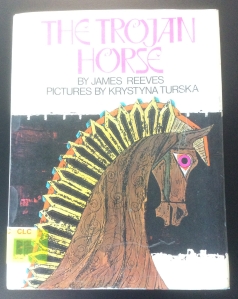 In the afternoon of the ‘show & tell’ we chose books from the University of Roehampton’s special collections and, as I told in a previous post, I picked a book called The Trojan Horse, by James Reeves and illustrated by Krystyna Turska as I thought it would prove to be an ideal counter part to the book I had brought with me. The episode of the wooden horse is framed in quite a different way and is told through the character of Ilias, a grown man (at the time of telling) but who was aged ten when Troy fell. He and his younger sister, Ida, escaped and now live far from their ruined former home. In The Wooden Horse Paris and Helen fell in love, but in this version Ilias describes how Paris stole Helen and kept her prisoner in Troy. Most of the war is glossed over, and it is really only the episode of how the horse appeared and was brought into Troy and the terrible consequences, that is told. It is Ilias’ life that frames the episode rather than Helen’s and we are given an insider’s view on events. As mentioned above I enjoy seeing how writers will encapsulate a particular myth, and particularly liked how these two books, which on the outside might lead one to thinking they would be similar, provide very different aspects of the story. Incidentally neither of them include the episode related in The Odyssey (IV: 265-289) about Helen calling out to men within the horse using the voices of their wives.
In the afternoon of the ‘show & tell’ we chose books from the University of Roehampton’s special collections and, as I told in a previous post, I picked a book called The Trojan Horse, by James Reeves and illustrated by Krystyna Turska as I thought it would prove to be an ideal counter part to the book I had brought with me. The episode of the wooden horse is framed in quite a different way and is told through the character of Ilias, a grown man (at the time of telling) but who was aged ten when Troy fell. He and his younger sister, Ida, escaped and now live far from their ruined former home. In The Wooden Horse Paris and Helen fell in love, but in this version Ilias describes how Paris stole Helen and kept her prisoner in Troy. Most of the war is glossed over, and it is really only the episode of how the horse appeared and was brought into Troy and the terrible consequences, that is told. It is Ilias’ life that frames the episode rather than Helen’s and we are given an insider’s view on events. As mentioned above I enjoy seeing how writers will encapsulate a particular myth, and particularly liked how these two books, which on the outside might lead one to thinking they would be similar, provide very different aspects of the story. Incidentally neither of them include the episode related in The Odyssey (IV: 265-289) about Helen calling out to men within the horse using the voices of their wives.
Whilst many of the contributor’s shared books or items that they remembered being influences from their childhood, I realised that I don’t actually recall any particular book with a classical theme from when I was a child. I feel a bit bereft! I’m sure there must have been books on mythology, but I can’t pinpoint when my interest in the classical world began to emerge. What I do remember well was in sixth form we were allowed to take Classical Studies (which we couldn’t do before then), so in the lower sixth we did the O level, and in the upper sixth the A level (only one year each). We had the most wonderful teacher, Mrs Janet Cox, whom I found very inspiring. I had obviously discovered the classical world before this point, but this was where I really started learning about it. Having a teacher who loved her subject made it come alive for all of us. She would also play music and bring in biscuits for us at break time, and there were classically themed posters on the walls of the classroom.
Incidentally, I also remember that she kept bees in her garden, and it is because of her that I joined The Green Party when still a teenager!
She taught Latin to a mere handful of students at lunchtimes (when I was doing O levels), sadly I never took this option! It was probably not suggested to me as I wasn’t particularly good at French (the one language we all had to do), and at the time it never really occurred to me to request joining the class. Grown up Karen is very sad that teenage Karen did not do this!!!!
I enjoyed the ‘show & tell’ and having the opportunity to hear about other people’s formative experiences and books, and have also relished having the opportunity to reflect on my own journey within Classics. I am also keenly looking out for children’s books that retell Helen’s story, and also that of the Trojan Horse.


